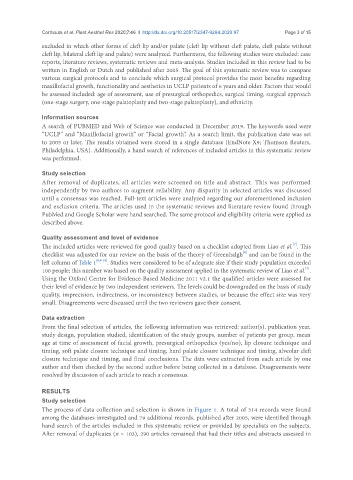Page 517 - Read Online
P. 517
Corthouts et al. Plast Aesthet Res 2020;7:46 I http://dx.doi.org/10.20517/2347-9264.2020.97 Page 3 of 15
excluded in which other forms of cleft lip and/or palate (cleft lip without cleft palate, cleft palate without
cleft lip, bilateral cleft lip and palate) were analyzed. Furthermore, the following studies were excluded: case
reports, literature reviews, systematic reviews and meta-analysis. Studies included in this review had to be
written in English or Dutch and published after 2005. The goal of this systematic review was to compare
various surgical protocols and to conclude which surgical protocol provides the most benefits regarding
maxillofacial growth, functionality and aesthetics in UCLP patients of 6 years and older. Factors that would
be assessed included: age of assessment, use of presurgical orthopedics, surgical timing, surgical approach
(one-stage surgery, one-stage palatoplasty and two-stage palatoplasty), and ethnicity.
Information sources
A search of PUBMED and Web of Science was conducted in December 2019. The keywords used were
“UCLP” and “Maxillofacial growth” or “Facial growth”. As a search limit, the publication date was set
to 2005 or later. The results obtained were stored in a single database (EndNote X9; Thomson Reuters,
Philadelphia, USA). Additionally, a hand search of references of included articles in this systematic review
was performed.
Study selection
After removal of duplicates, all articles were screened on title and abstract. This was performed
independently by two authors to augment reliability. Any disparity in selected articles was discussed
until a consensus was reached. Full-text articles were analyzed regarding our aforementioned inclusion
and exclusion criteria. The articles used in the systematic reviews and literature review found through
PubMed and Google Scholar were hand searched. The same protocol and eligibility criteria were applied as
described above.
Quality assessment and level of evidence
[7]
The included articles were reviewed for good quality based on a checklist adopted from Liao et al. . This
[8]
checklist was adjusted for our review on the basis of the theory of Greenhalgh and can be found in the
left column of Table 1 [6,9-18] . Studies were considered to be of adequate size if their study population exceeded
[7]
100 people; this number was based on the quality assessment applied in the systematic review of Liao et al. .
Using the Oxford Centre for Evidence-Based Medicine 2011 v2.1 the qualified articles were assessed for
their level of evidence by two independent reviewers. The levels could be downgraded on the basis of study
quality, imprecision, indirectness, or inconsistency between studies, or because the effect size was very
small. Disagreements were discussed until the two reviewers gave their consent.
Data extraction
From the final selection of articles, the following information was retrieved: author(s), publication year,
study design, population studied, identification of the study groups, number of patients per group, mean
age at time of assessment of facial growth, presurgical orthopedics (yes/no), lip closure technique and
timing, soft palate closure technique and timing, hard palate closure technique and timing, alveolar cleft
closure technique and timing, and final conclusions. The data were extracted from each article by one
author and then checked by the second author before being collected in a database. Disagreements were
resolved by discussion of each article to reach a consensus.
RESULTS
Study selection
The process of data collection and selection is shown in Figure 1. A total of 314 records were found
among the databases investigated and 79 additional records, published after 2005, were identified through
hand search of the articles included in this systematic review or provided by specialists on the subjects.
After removal of duplicates (n = 103), 290 articles remained that had their titles and abstracts assessed in

